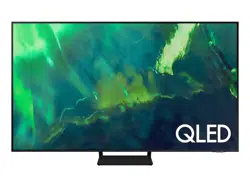Documents: Go to download!
User Manual
- User Manual - (English)
- Energy Guide - (English)
- Specification - (English)
- Spec Sheet (web) - (English)

- Guide
- Troubleshooting
- FAQ
- Accessibility Guidance
Table of contents
User manual 65" Q70A QLED 4K Smart TV 2021 Samsung QN65Q70AAFXZA
Guide
Connections
You can watch live broadcasts by connecting a coaxial cable to your TV and can get access to the Internet by using a LAN cable or wireless access point. Using various connectors, you can also connect external devices.
It shows you how to connect various external devices, such as video devices, game consoles, and PCs using pictures. If you select the connection method and an external device, the connection details appear.
- Audio Device: HDMI (eARC), Optical, Bluetooth, Wi-Fi, Wi-Fi Speaker Surround Setup
- Video Device: HDMI
- Smartphone: Screen Sharing (Smart View), SmartThings, Apple AirPlay, NFC on TV, Tap View
- PC: HDMI, Screen Sharing (Wireless), Apple AirPlay
- Input Device: Remote Control, Keyboard, Mouse, USB Gamepad, USB Camera, Bluetooth Device
- Game Console: HDMI
External Storage: USB Flash Drive, Hard Disk Drive (HDD)
- The connection method and available external devices may differ depending on the model.
- Some functions may not be supported depending on the model or geographical area.
- Using HDMI Troubleshooting, you can check the connection to HDMI cable and external devices (takes approximately 2 minutes).
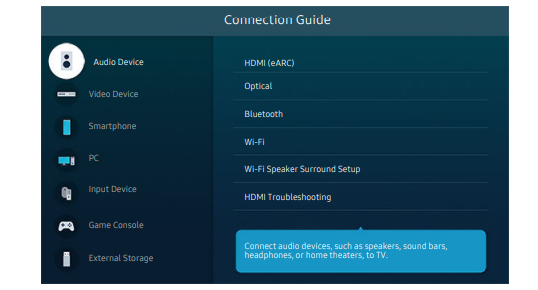
- The image on your TV may differ from the image above depending on the model and geographical area.
Connecting an Antenna
You can connect a coaxial cable to your TV.
- An antenna connection is not necessary if you connect a cable box or satellite box.
- The port on your TV may differ from the following fi˝Їθʪ depending on the product model and region.

Connecting to the Internet
Establishing a wired Internet connection
If you connect a LAN cable, the TV automatically accesses the Internet.
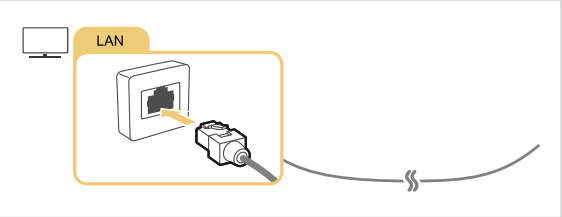
- If the TV does not automatically connect to the network, refer to "Network Issues" in "Troubleshooting."
- To connect a LAN cable, use a CAT 7 (*STP type) cable for the connection. (100/10 Mbps) * Shielded Twisted Pair
- The TV will not be able to connect to the Internet if your network speed is below 10 Mbps.
- This function may not be supported depending on the model
Establishing a wireless Internet connection
Make sure that you have the wireless access point's name (SSID) and password settings before attempting to connect. The network name (SSID) and security key are available on the wireless access point's configuration screen. See the wireless access point's user manual for more information.

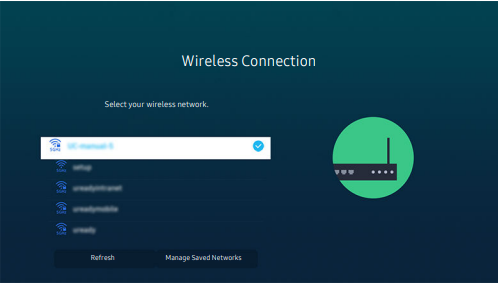
- The image on your TV may differ from the image above depending on the model and geographical area.
- If no wireless access point is found, select Add Network at the bottom of the list and enter the network name (SSID).
- If your wireless access point has a WPS or PBC button, select Use WPS at the bottom of the list, and then push the WPS or PBC button on your access point within 2 minutes. The TV will connect automatically.
- To view or delete previously connected network names (SSIDs), move the focus to Manage Saved Networks, and then press the Select button.
- To disconnect Wi-Fi, select Disconnect in Settings General Network Network Status.
Connecting an IP control device to the TV
You can connect an IP control device to the TV remotely to manage your IP device.
- To use this function, Power On with Mobile must be turned on.
- Turning this feature on may allow other IP control devices to control your TV. We recommend turning this feature on only if an authorized third-party custom controller is installed and configuration configuration for a Samsung TV and if your Wi-Fi network is password protected.
- This function may not be supported depending on the model.
Connection Cables for External Devices
You can view detailed information about the connection cables for external devices that can be connected to the TV.
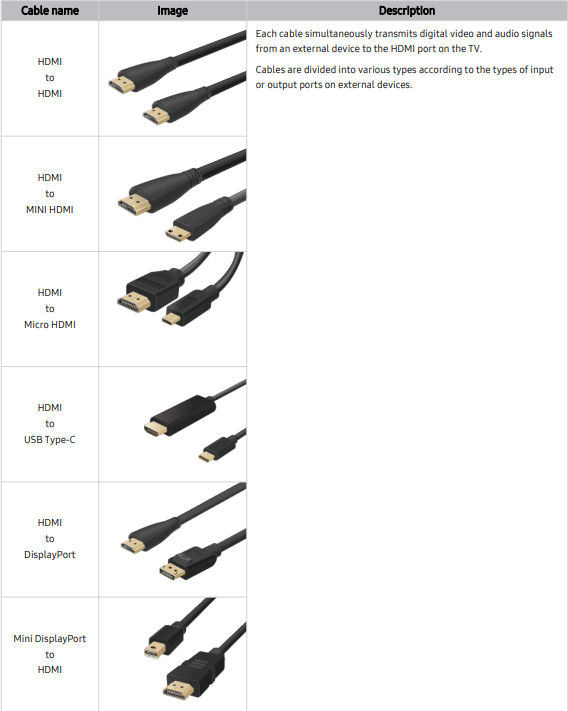
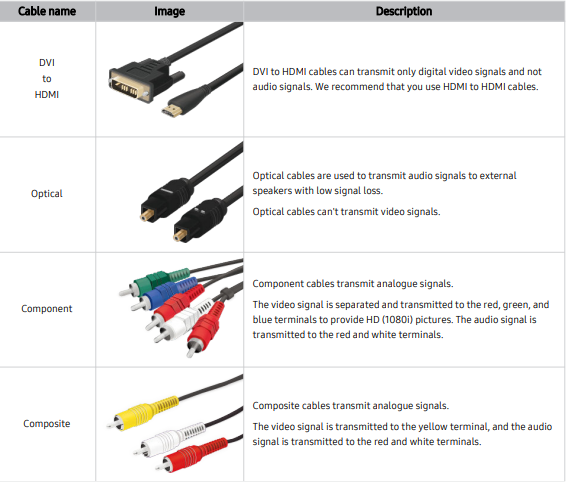
Switching between external devices connected to the TV
When you select a connected external device on the Source screen, the output of the selected device is displayed on the TV's screen.
- To control a device (Blu-ray player, game console, etc.) that supports universal remote control with the TV's remote control, connect the device to an HDMI port on the TV, and then turn on the device. The output displayed on the TV is automatically switched to the output of the device or you can ʀͱ͝fi˝Їθʪ universal remote control for the device automatically. For more information, refer to "Controlling External Devices with a Samsung Remote Control - Using the Universal Remote."
- When a USB device is connected to the USB port, a pop-up message appears that lets you switch easily to the media content listed on the device.
- This function may not be supported depending on the device and geographical area.
Editing the name and icon of an external device
You can change the port name for a connected external device or add it to the Home Screen.
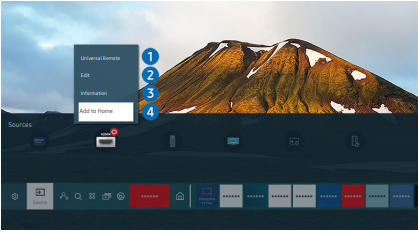
- Move the focus to a connected external device.
- Press the up directional button. The following functions become available:
Connection Notes
- The number of connectors, and their names and locations may differ with the model.
- Refer to the external device's operating manual when connecting it to the TV. The number of external device connectors, and their names and locations may differ with the manufacturer.
Connection notes for HDMI
- The following types of HDMI cables are recommended: – High Speed HDMI Cable – High Speed HDMI Cable with Ethernet – Premium High Speed HDMI Cable – Premium High Speed HDMI Cable with Ethernet – Ultra High Speed HDMI Cable • Use an HDMI cable with a thickness of 0.66 inches (17 mm) or less.
- Using a non-certified HDMI cable may result a blank screen or a connection error.
- Some HDMI cables and devices may not be compatible with the TV due to different HDMI specifications.
- This TV does not support HDMI Ethernet Channel. Ethernet is a Local Area Network (LAN) built with coaxial cables standardized by the IEEE.
- Use a cable shorter than 10 feet (3 m) to get the best UHD viewing quality.
- Many computer graphics adaptors do not have HDMI ports, but have DVI or DisplayPort ports instead. If your PC does not support HDMI video out, connect your PC with a DVI to HDMI or HDMI to DisplayPort cable.
- When the TV is connected to an external device, such as a DVD/BD player or a set-top box via HDMI, power sync mode will be automatically activated. In the power sync mode, the TV continues to detect and connect external devices via HDMI cable. This function can be deactivated by removing the HDMI cable of the connected device.
Connection notes for audio devices
- For better audio quality, it is good to use an AV receiver.
- If you connect an external audio device using an optical cable, the Sound Output setting automatically changes to the connected device. However, to make this happen, you must turn on the external audio device before connecting the optical cable.
- An unusual noise coming from a connected audio device while you are using it, may indicate a problem with the audio device itself. If this occurs, ask for assistance from the audio device's manufacturer.
- Digital audio is only available with 5.1 channel broadcasts.
Connection notes for computers
- For the resolutions supported by the TV, refer to "Read Before Connecting a Computer (Supported Resolutions)."
- If you want to connect your PC and TV wirelessly, both of them must be connected to each other on the same network.
- When sharing content with other network-based devices, such as those in an IP (Internet Protocol) storage system, sharing may not be supported due to the network’s configuration, quality, or functionality, for example, if the network has an NAS (Network-Attached Storage) device.
Connection notes for mobile devices
- To use the Smart View function, the mobile device must support a mirroring function, such as Screen Mirroring or Smart View. To check whether your mobile device supports the mirroring function, refer to the mobile device's user manual.
- The Screen Sharing (Smart View) feature may not operate smoothly in a 2.4GHz environment. For better experience, 5.0GHz is recommended. 5GHz may not be available depending on the model.
- To use Wi-Fi Direct, the mobile device must support the Wi-Fi Direct function. To check whether your mobile device supports Wi-Fi Direct, refer to the mobile device's user manual.
- The mobile device and your Smart TV must be connected to each other on the same network
- The video or audio may stop intermittently, depending on network conditions.
- When sharing content with other network-based devices, such as those in an IP (Internet Protocol) storage system, sharing may not be supported due to the network’s configuration, quality, or functionality, for example, if the network has an NAS (Network-Attached Storage) device.
Remote Control and Peripherals
You can control TV operations with your Samsung Smart Remote. Pair external devices, such as a keyboard, for ease of use
About the Samsung Smart Remote (QLED TV/AU9 Series or higher/The Frame)


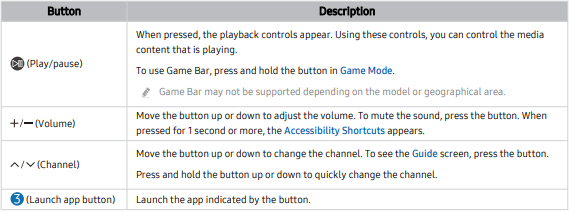
- Use the Samsung Smart Remote less than 20 feet (6 m) from the TV. The usable distance may vary with the wireless environmental conditions.
- The images, buttons, and functions of the Samsung Smart Remote may differ with the model or geographical area.
- To use the Samsung Smart Remote to control a compatible external device that does not support HDMI-CEC (Anynet+), you must ʀͱ͝fi˝Їθʪ universal remote control for the device. For more information, refer to "Controlling External Devices with a Samsung Remote Control - Using the Universal Remote."
- To use the Samsung Smart Remote to control a compatible external device that does support HDMI-CEC (Anynet+), connect the device to an HDMI port on the TV using an HDMI cable. For more information, refer to "Using Anynet+ (HDMI-CEC).
Connecting the Samsung Smart Remote to the TV
When you turn on the TV for the fiθϑϩ time, the Samsung Smart Remote pairs to the TV automatically. If the Samsung Smart Remote does not pair to the TV automatically, point it at the front of the TV, and then press and hold the and buttons simultaneously for 3 seconds or more.
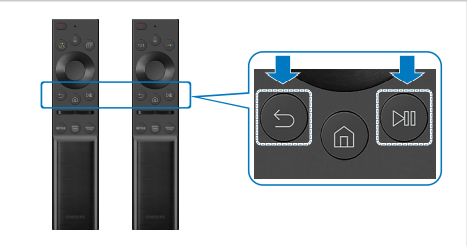
- The images, buttons, and functions of the Samsung Smart Remote may differ with the model or geographical area.
- For more information about the Samsung Smart Remote, refer to "About the Samsung Smart Remote (QLED TV/AU9 Series or higher/The Frame)."
- For more information about the Samsung Smart Remote that comes with AU8 Series, refer to "About the Samsung Smart Remote (AU8 Series) ."
Controlling External Devices with a Samsung Remote Control - Using the Universal Remote
You can control external devices connected to the TV using a Samsung remote control. To control external devices, register them by following the instructions on the screen.
- This function may not be supported depending on the model or geographical area.
- You can also use the Anynet+ (HDMI-CEC) function to operate external Samsung devices with your TV's remote control without any additional setup. For more information, refer to "Using Anynet+ (HDMI-CEC)."
- ƊΧʪʀ̈fiʀ external devices connected to the TV may not support the universal remote feature.
- Do not place any obstacles in front of an external device and TV's logo. It may cause improper transmitted signals from the remote control.
- The TV memorizes both the external device and its connection port (HDMI 1, HDMI 2, etc.).
- If you have ʒ̈˙fiʀЇ̷ϩц controlling external devices with the Universal Remote, try adjusting the positions of the external devices.
- This function may not operate properly depending on the TV installation environment and the features of external devices.
Using Anynet+ (HDMI-CEC)
You can use the TV's remote control to control external devices that are connected to the TV by an HDMI cable and that support Anynet+ (HDMI-CEC). Note that you can only set up and operate Anynet+ (HDMI-CEC) with the remote control.
Connecting an external device through Anynet+ and using their menus
- Set Anynet+ (HDMI-CEC) to On.
- Connect an HDMI-CEC-compliant device to the TV.
- Turn on the connected external device.
The device is automatically connected to the TV. After the connection process is finished you can access the menu of the connected device using your TV remote and control the device.
Read before connecting an Anynet+ (HDMI-CEC) device
- Anynet+ (HDMI-CEC)-enabled devices must be connected to the TV with an HDMI cable. Note that some HDMI cables may not support Anynet+ (HDMI-CEC).
- You can configure the TV's Universal Remote to control third-party cable boxes, Blu-ray players, and home theaters that do not support HDMI-CEC. For more information, refer to "Controlling External Devices with a Samsung Remote Control - Using the Universal Remote."
- Anynet+ cannot be used to control external devices that do not support HDMI-CEC.
- The TV remote control may not work under certain circumstances. If this occurs, set up the device as an Anynet+ (HDMICEC)-enabled device again.
- Anynet+ (HDMI-CEC) works only with external devices that support HDMI-CEC, and when those devices are either in standby mode or turned on.
- Anynet+ (HDMI-CEC) can control up to 12 compliant external devices (up to 3 of the same type) except for home theaters. Anynet+ (HDMI-CEC) can control only one home theater system.
- To listen to 5.1 channel audio from an external device, connect the device to the TV via an HDMI cable and connect a 5.1 home theater system directly to the external device's digital audio output connector.
- If an external device has been set up for both Anynet+ and a universal remote control, the device can be controlled only with the universal remote control.
Using the keyboard and mouse
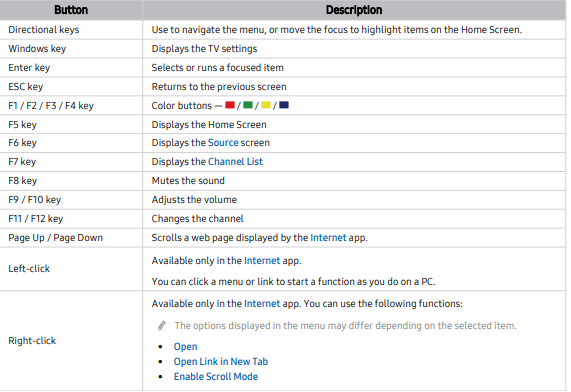
Using Art Mode
Viewing images
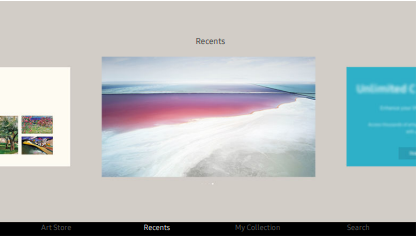
To view an image in Art mode, select one of the menus below. To switch to the sub menu where you can select images, press the Select button, one of the four directional buttons, or button in Art mode. Then, use the directional buttons on the remote control to move to desired image, and then press the Select button. Set appears at the bottom of the selected image, and you can view the selected image in Art mode.
Viewing images by time
- Use the directional buttons on the remote control to move to My Collection
- Use the directional buttons to move to Favorites or My Photos. To view the images on the mobile device connected via the USB or SmartThings app, select the desired images on the connected device and then save them into My Photos
- Use the directional buttons on the remote control select the Start Slideshow or Start Slideshow (Random).
- Use the directional buttons on the remote control to select the time interval at which images are to be switched, and then press the Select button.
Import images from an external storage device
- Connect an external storage device that contains images to the TV.
- Use the directional buttons on the remote control to move to My Collection, and then move to the connected external storage device.
- Use the directional buttons on the remote control to move to an image, and then press the Select button. You can select multiple images.
- Use the directional buttons on the remote control to move to Save to My Photos at the bottom of the screen, and then press the Select button.
- The selected image or images are saved in My Photos. Recommended resolutions: 3840 x 2160
Remove images from My Collection
You can remove the saved images from My Collection.
- Use the directional buttons on the remote control to move to My Collection.
- Use the directional buttons on the remote control to move to Favorites or My Photos.
- Use the directional buttons on the remote control to move to Remove, and then press the Select button.
- Use the directional buttons on the remote control to move to an image, and then press the Select button. You can select multiple images.
- Use the directional buttons on the remote control to move to Remove Selected at the bottom of the screen, and then press the Select button.
Buying images from Art Store
- Use the directional buttons on the remote control to move to Art Store
- Use the directional buttons on the remote control to move to a topic, and press the Select button. You can select any subtopics or images on the screen. The entry path may differ by each topic.
- Use the directional buttons on the remote control to move to an image, and press the Select button.
- Use the directional buttons on the remote control to move to Details at the bottom of the screen, and then select Acquire Artwork. Displays Get Trial Membership or Free Trial if you have not joined The Art Store Membership.
- Use the directional buttons on the remote control to select payment methods, and then press the Select button.
- Follow the on-screen instructions to procedure payment.
Subscribing to The Art Store Membership
When you subscribe to The Art Store Membership, you can use Art Store unlimitedly and enjoy various art works by replacing them with new ones according to your preferences.
- Use the directional buttons on the remote control to move to Art Store.
- Use the directional buttons on the remote control to move to Membership
- Follow the on-screen instructions to enter your membership information.
Setting the style of the selected image

Setting up Art mode
In Art mode, use the directional buttons on the remote control to move to the Settings menu item at the bottom of the screen. You can adjust the following functions:
- Brightness Use the directional buttons on the remote control to move to Modify at the bottom of the screen, and then press the Select button. In the next screen, adjust the picture brightness. After selecting the desired settings, press the Select button on the remote control.
- Color Tone Use the directional buttons on the remote control to move to Modify at the bottom of the screen, and then press the Select button. In the next screen, adjust the color of your displayed artwork. After selecting the desired settings, press the Select button on the remote control.
- Sleep After If no motion is detected around the TV for the set time, the TV turns off automatically. Use the directional buttons on the remote control to move to the bottom items. After selecting the desired time, press the Select button on the remote control.
- Motion Detector The sensitivity of the motion detector function can be adjusted. Use the directional buttons on the remote control to move to the bottom items. After selecting the desired sensitivity, press the Select button on the remote control.
- Night Mode When this function is turned on, the TV turns off automatically if no light is detected around the TV. Use the directional buttons on the remote control to move to the bottom items, and then turn this function on or off.
Using PC on TV
Using PC on TV - Easy Connection
You can easily use remote access function after installing PC on TV - Easy Connection on your PC. Follow the instructions on the screen to download and install the PC on TV - Easy Connection PC app. Then you can easily connect a remote PC.
- Download the PC on TV - Easy Connection PC app from smsng.co/PConTV and then install it on your PC.
- Log in with the same Samsung Account for both TV and PC.
- When the PC is turned on and connected via the network, PC on TV's Home screen displays the PC.
Connecting a Remote PC
Provides Remote Desktop Connection (RDP) for remotely connecting to a PC running on Windows and Virtual Network Computing (VNC) for a PC running on Mac. To remotely connect to a PC, you must enter the IP address of the remote PC or select a saved Χθͱfi̷ʪࢋ Enter a correct username and password and select a correct protocol. If there is any computer that can be accessed via the same network, the found IP and protocol are displayed.
- Aͱ͝fi˝Їθʪ your computer’s settings to use the PC on TV function.
- Enter the required settings for connecting the computer remotely.
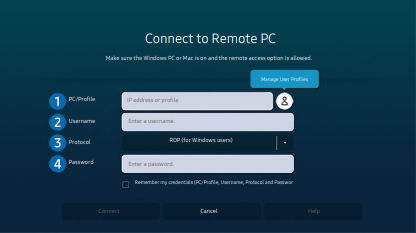
Using Samsung DeX
- Samsung DeX can be connected from the TV via wireless network.
- When the mobile device does not appear on the screen, select Mobile Connection Guide and then follow the screen instructions. Some models may not be searched when connecting the TV from a mobile device through Samsung DeX. In this case, access the DeX Guide on the screen in which you can perform connection by following the screen instructions.
Using the Apps Service
You can enjoy a wide range of content, including news, sports, weather, and games by installing the corresponding apps on your TV.
- To use this feature, the TV must be connected to the Internet.
- When Smart Hub is launched for the fiθϑϩ time, the default apps are automatically installed. The default apps may differ depending on the model or geographical area.
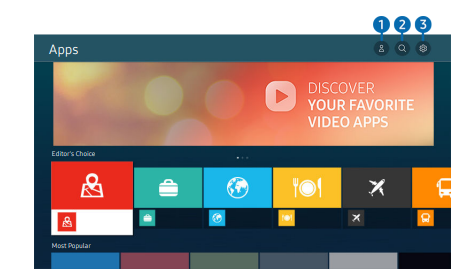
Installing an app
- Move to the app you want to install, and then press the Select button. The detailed information screen appears.
- Select Install. When the installation is complete, the Open menu appears.
- Select Open to run the app immediately.
Managing installed apps
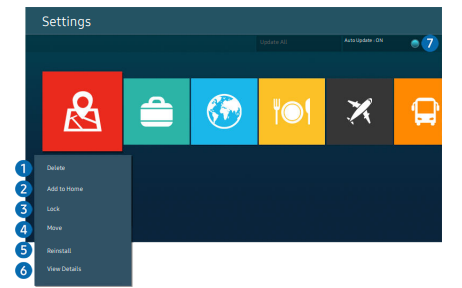
Using the e-Manual
Launching the e-Manual
You can view the embedded e-Manual that contains information about your TV's key features.
- You can download a copy of the e-Manual from Samsung's website to view or print on your PC or mobile device (http:// www.samsung.com).
- Some menu screens cannot be accessed from the e-Manual.
Using the buttons in the e-Manual
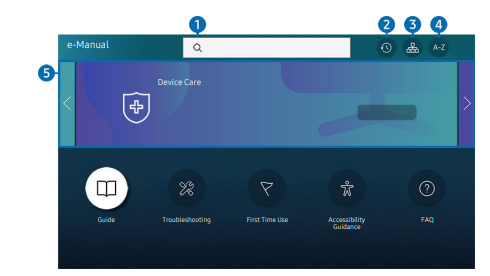
Using Digital Butler
Using the TV, you can control devices connected via Bluetooth, BLE(Bluetooth Low Energy), or Wi-Fi by using the remote control.
- Depending on the TV or device position, you may not operate functions with the remote control. In this case, move the device.
- This function may not be supported depending on the model.
- This function may not be supported depending on the device type.
Registering a device
- When there is any device detected near the TV, a registration pop-up appears on the TV screen. When there is no device detected, the pop-up may not appear.
- Select Register to register the device.
Digital Butler screen layout
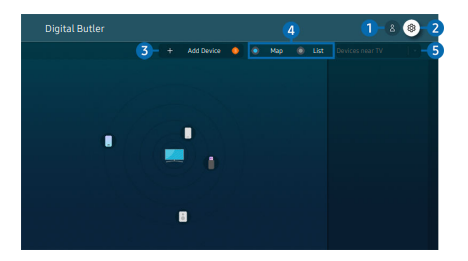
Playing pictures/video/music
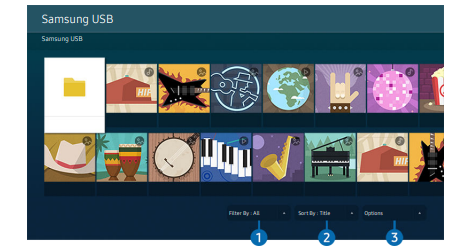
Listening to your mobile device sound through the TV speaker using Sound Mirroring
Enjoy listening to music in your living space. Visualizations are generated on your TV that alter and respond to the frequency of your music.
- Search for and connect to your TV from the (Bluetooth) device list on your mobile device.
- Select media content to play on your mobile device.
Starting Bixby using buttons on the Samsung Smart Remote
You can have conversation with Bixby using the Samsung Smart Remote buttons. Press and hold the button on your Samsung Smart Remote, say a command, and then release the button. To view the Bixby guide, press the button once:
- When you press the button, the Explore Now button appears at the bottom of the screen. Press the Select button to go to the Explore Bixby screen.
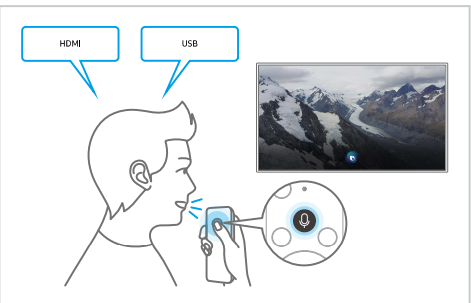
Learning about the Explore Bixby Screen
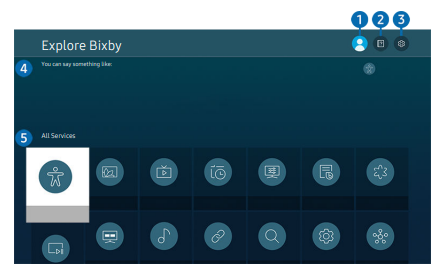
Read Before Using Bixby
- The supported voice interaction languages and features may differ depending on the geographical area.
- If the language set differs from the language of your country, some features are not available
- Bixby is available only when the TV is connected to the Internet.
- Even if the TV is connected to the Internet, there may be no response due to a Bixby server error.
- The existing functional specifications may be changed if Bixby is updated.
- Bixby is available only on TVs that support it and come with remote controls that have a microphone.
- Symbols including "-" and special characters are not supported. Consequently, if a word or sentence contains numeric values or symbols, the function may not operate properly.
- Searched results may not provide complete results.
- You may be required to pay for some apps. Consequently, you may encounter a service application or contract.
Using the Game Bar
Learning about the Game Bar
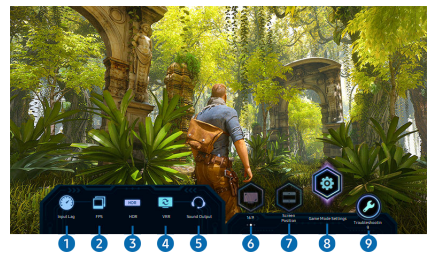
Setting the Super Ultra Wide Game View
Set your PC Screen resolution to match the selected Screen Ratio in the Game Bar before activating the Super Ultra Wide Game.
- Check if the game supports Ultra Wide resolution
- If you set the resolution on your PC for the fiθϑϩ time, you can change the Screen Ratio through the Game Bar on your TV.

- The supportable resolutions may differ depending on the model or HDMI port connected to the PC.
- After setting the resolution, check if the PC’s Window or Mac screen changes when you change the Screen Ratio on the Game Bar of your TV.
- This function may not be supported depending on the OS or device.
Troubleshooting of the game screen and audio problems
After changing the Screen Ratio on the Game Bar, if the game screen and sound are not output properly, try to solve the problems as shown below.
- Check to see if the game supports Ultra Wide or your PC supports the Ultra Wide resolution.
- Restart the game after exiting it.
- Select the same resolution as that of the Game Bar.
- When the Screen Ratio changes properly, the screen appears as shown below.

TV Viewing
You can use convenient features while watching TV. Additionally, you can edit the channel list or create favorite channel lists.
Using the Guide
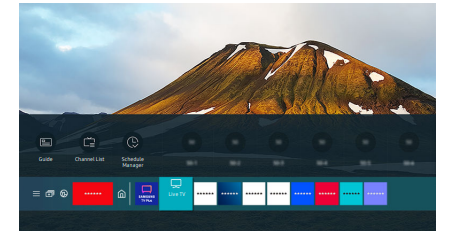
- The image on your TV may differ from the image above depending on the model and geographical area
In the Guide, you can see the daily program schedules for each station, see program information, choose a program to watch, and set up a schedule viewing or recording.
- Recording may not be supported depending on the model or geographical area.
- To view the Guide while watching TV, press the (Channel) button on the Samsung Smart Remote or Remote Control.
- To see information about analog channels and use the analog channel functions of the Guide, you must fï͝ϑ˵ the service provider settings in initial setup.
- To view the Guide, you must fiθϑϩ set the TV's clock
Using the instant and schedule recording options from the Guide screen
- Instant Recording Select a live program from the Guide, press and hold the Select button, and then select Record from the pop-up menu to start recording immediately.
- Schedule Recording Select a program scheduled to be broadcast, press the Select button, and then select Schedule Recording to set up a scheduled recording of the scheduled program.
Using the instant and schedule recording options while watching a program
- Instant Recording If you select Record after pressing the button twice, and then press the Select button or after pressing the button once while watching a broadcast, recording starts.
- Schedule Recording Press the Select button while watching a program to display the program info window. Use the left or right directional button to select a scheduled program. Press the Select button, and then select Schedule Recording to set up a scheduled recording of the scheduled program.
Using the schedule viewing options from the guide screen
- On the Guide screen, select a program you would like to view, press and hold the Select button, and then select Schedule Viewing in the pop-up menu that appears.
Using the schedule viewing options while watching a program
- Press the Select button while watching TV. The Program Info window appears. Select a program that will be broadcast using the left or right directional buttons. Press the Select button, and then select Schedule Viewing to schedule viewing of that program.
Precautions and Notes
Before using the recording and schedule recording functions
- To set up a Schedule Recording, you must first set the TV's clock. Set the Clock.
- You can set up a maximum total of 30 Schedule Viewing and Schedule Recording entries.
- Recordings are DRM-protected and therefore cannot be played back on a computer or on a different TV. In addition, these files cannot be played back on your TV if its video circuit has been replaced.
- For a USB device for recording, it is recommended to use the USB hard disk that supports USB 2.0 or later and 5,400 rpm or higher. However, RAID-type USB hard drives are not supported.
- USB memory sticks are not supported.
- The total recording capacity may differ with the amount of available hard drive space and the recording quality level.
- Schedule Recording requires at least 100 MB of free space on the USB storage device. Recording will stop if the available storage space falls below 50 MB while recording is in progress.
- If the available storage space falls below 500 MB while both the Schedule Recording and Timeshift functions are in progress, only the recording will stop.
- The maximum recording time is 720 minutes.
- Videos are played according to the TV settings.
- If the input signal is changed while recording is in progress, the screen will go blank until the change is made. In this case, recording will resume, but the button will not be available.
- When using the Record or Schedule Recording function, the actual recording may start a second or two later than the specified time.
- If the Schedule Recording function is operating while a recording is being made on an HDMI-CEC external device, the priority is given to the Schedule Recording.
- Connecting a recording device to the TV automatically deletes abnormally saved recorded files.
- If the Sleep Timer or Auto Power Off has been set, the TV will override these settings, continue to record, and turn off after the recording has ended.
Before using the timeshift function
- For a USB device for recording, it is recommended to use the USB hard disk that supports USB 2.0 or later and 5,400 rpm or higher. However, RAID-type USB hard drives are not supported.
- USB memory sticks or flash drives are not supported.
- The total recording capacity may differ with the amount of available hard drive space and the recording quality level.
- If the available storage space falls below 500 MB while both the Schedule Recording and Timeshift functions are in progress, only the recording will stop.
- The maximum amount of time available for the Timeshift function is 90 minutes.
- The Timeshift function is not available for locked channels.
- Time-shifted videos are played according to the TV settings.
- The Timeshift function may be terminated automatically once it reaches its maximum capacity.
- The Timeshift function requires at least 1.5 GB of free space available on the USB storage device.
Read Before Using Apps
- If you want to download new apps using Apps, first sign in to your Samsung account.
- Due to the product characteristics featured on Samsung Smart Hub, as well as limitations in available content, certain features, applications, and services may not be available on all devices or in all territories. Visit http://www.samsung.com for more information on specific device information and content availability. Services and content availability are subject to change without prior notice.
- Samsung Electronics takes no legal responsibility whatsoever for any interruption of app services caused by the service provider for any reason.
- Application services may be provided in English only and available content may differ with the geographical area.
- For more information about applications, visit the applicable service provider's website.
- An unstable Internet connection may cause delays or interruptions. In addition, applications may terminate automatically depending on the network environment. If this occurs, check your Internet connection and try again.
- Application services and updates may become unavailable.
- Application content is subject to change by the service provider without prior notice
- Specific services may differ with the version of the application installed on the TV.
- An application's functionality may change in future versions of the application. If this occurs, run the application's tutorial or visit the service provider's website.
- Depending on the service provider's policies, certain applications may not support multitasking.
Read Before Using the Internet Function
- File download is not supported.
- The Internet function may not be able to access certain websites, including websites operated by certain companies.
- The TV does not support playback of flash videos.
- E-commerce for online purchases is not supported.
- ActiveX is not supported.
- Only a limited number of fonts are supported. Certain symbols and characters may not be displayed properly.
- The response to remote commands and the resulting on-screen display may be delayed while a web page is loading. • Loading a web page may be delayed or suspended completely depending on the status of the participating systems.
- Copy and paste operations are not supported.
- When composing an email or a simple message, certain functions such as the font size and color selection may not be available.
- There is a limit to the number of bookmarks and the size of the log file that can be saved.
- The number of windows that can be opened concurrently is limited.
- Web browsing speed will differ with the network environment.
- Browsing history is saved from latest to oldest, with the oldest entries being overwritten first.
- Depending on the types of video/audio codecs supported, you may not be able to play certain HTML5 video and audio files.
- Video sources from PC-optimized streaming service providers may not play properly on our proprietary Internet browser.
Supported subtitles
Subtitle formats

Video formats with subtitles
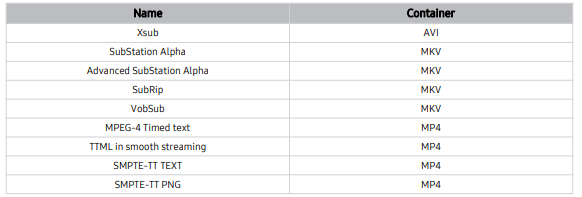
Supported image formats and resolutions

Supported music formats and codecs

Supported video codecs (QLED TV except for Q6*A and Q5*A Series/The Frame)
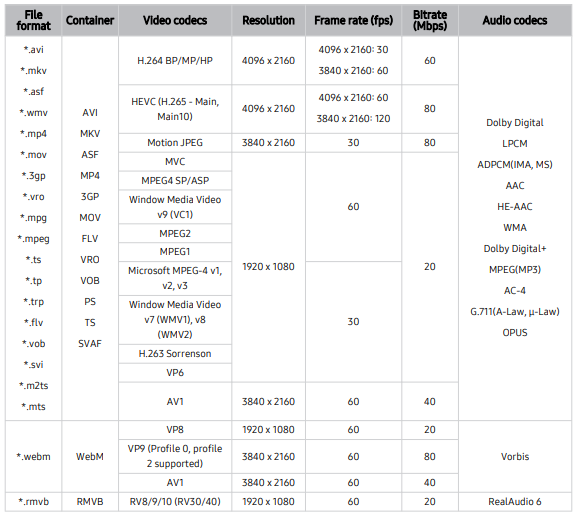
Supported video codecs (Q6*A/AU9 Series)
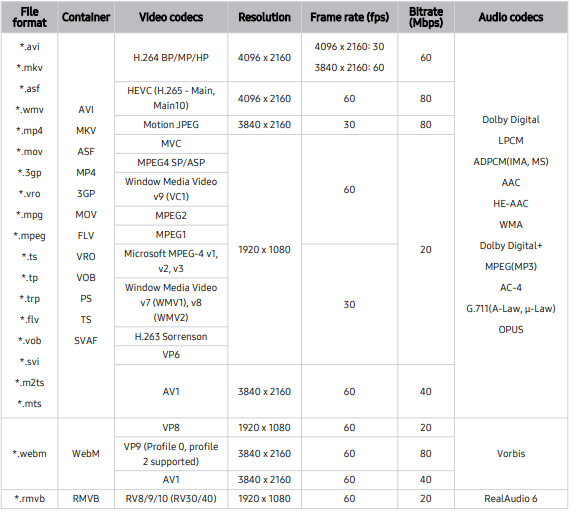
Other restrictions
- Codecs may not function properly if there is a problem with the content.
- Video content does not play or does not play correctly if there is an error in the content or container.
- Sound or video may not work if they have standard bit rates/frame rates above the TV’s compatibility ratings.
- If the Index Table is has an error, the Seek (Jump) function will not work.
- When playing video over a network connection, the video may not play smoothly because of data transmission speeds.
- Some USB/digital camera devices may not be compatible with the TV
- HEVC codec is only available in MKV / MP4 / TS containers.
- The MVC codec is supported partly.
Video decoders
- H.264 UHD is supported up to Level 5.1, and H.264 FHD is supported up to Level 4.2 (TV does not support FMO / ASO / RS).
- HEVC UHD is supported up to Level 5.2, and HEVC FHD is supported up to Level 4.1 (QLED TV except for Q6*A Series/The Frame).
- HEVC UHD is supported up to Level 5.1, and HEVC FHD is supported up to Level 4.1 (Q6*A except for 32Q6*A model and AU9 Series).
- VC1 AP L4 is not supported.
- GMC 2 or above is not supported.
Audio decoders
- WMA is supported up to 10 Pro 5.1 channels.
- WMA1, WMA lossless / Voice are not supported.
- QCELP and AMR NB/WB are not supported.
- Vorbis is supported for up to 5.1 channels.
- Dolby Digital+ is supported for up to 5.1 channels.
- The supported sample rates are 8, 11.025, 12, 16, 22.05, 24, 32, 44.1, and 48 KHz, and differ with the codec.
Picture sizes and input signals
The Picture Size is applied to the current source. The applied Picture Size will remain in effect whenever you select that source unless you change them.
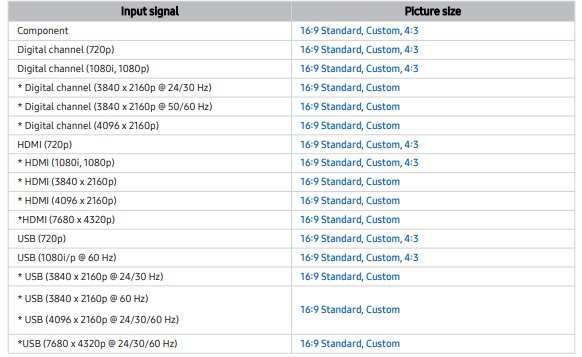
Installing an anti-theft lock
- An anti-theft lock is a physical device that can be used to protect the TV against theft. Look for the lock slot on the back of the TV. The slot has a icon next to it. To use the lock, wrap the lock cable around an object that is too heavy to carry and then thread it through the TV's lock slot. The lock is sold separately. The method of using an antitheft lock may differ for each model. Refer to the lock's user manual for more information.
Supported Resolutions for FreeSync (VRR)

Supported Resolutions for Wide Screen
When the computer is connected and Game Mode is set to On or Auto, the wide screen is activated on Game Bar. When you press and hold the button in Game Mode, Game Bar runs.

Read Before Connecting a Computer (Supported Resolutions)
- When you connect your TV to a computer, set the computer's video card to one of the standard resolutions listed in the tables below. The TV will automatically adjust to the resolution you choose. Note that the optimal and recommended resolutions are 3840 x 2160 @ 60 Hz (UHD models) and 7680 x 4320 @ 60 Hz (QN8**A series or higher). Choosing a resolution not included in the tables can result in a blank or fl̈ʀ̧ʪθ̈͝˝ screen or can turn on only the receiver of the remote control. Refer to the user manual of your graphics card for compatible resolutions.
IBM

MAC

VESA DMT

VESA CVT

Troubleshooting
If you have a problem with your TV, you can access various solutions while watching TV. If your problem is not addressed in the Troubleshooting section, view the FAQ section or contact the Samsung Call Center.
Testing the picture
Before you review the list of problems and solutions below, use Picture Test to determine if the problem is caused by the TV. Picture Test displays a high definitions picture you can examine for flɇиϑ or faults.
Component Connections and Screen Color
- If the test results indicate that the problem is not caused by the TV, do the following:
- When using the One Connect Box, confirm that its video input connectors are connected to the correct external device video output connectors.
- When using the component cable, confirm that the green (Y), blue (Pb), and red (Pr) jacks are plugged into their proper connectors.
- For more information about how to connect an external device, run Connection Guide.
Problems Powering On
- If you are having problems powering on your TV, there are a number of things to check before calling the service department.
- Confirm that the TV's power cord is connected correctly at both ends and that the remote control is operating normally.
- Make sure that the antenna cable or cable TV cable is firmly connected.
- If you have a cable box or satellite box, confirm that it is plugged in and turned on.
- In case of a model that supports One Connect Box, check the One Invisible Connection or One Connect Cable between the TV and One Connect Box.
The picture is distorted
- The compression of video content may cause picture distortions, especially in fast moving pictures from sports programs and action movies.
- If the signal reception is weak or poor, screen distortion may be visible but it is not a malfunction.
- Mobile phones used close to the TV (within 3.2 ft) may cause noise on analog and digital channels.
The color is wrong or missing
- If you’re using a Component connection, make sure that the Component cables are connected to the correct jacks.
- Incorrect or loose connections may cause color problems or a blank screen.
Testing the sound
If the TV plays the Sound Test melody without distortion, there may be a problem with an external device or the broadcast signal's strength.
The picture is good but there is no sound.
- If you are using an external device, check the device’s audio output option.
- For example, you may need to change your cable box’s audio option to HDMI if the box connected to your TV is using an HDMI cable.
- To listen to computer sound, connect an external speaker to the computer’s audio output connector.
- If your TV has a headphone jack, make sure there is nothing plugged into it.
- Reboot the connected device by disconnecting and then reconnecting the device’s power cable.
- With a set-top box or cable box, check the cable connection and reboot the external device. When the symptom persists, contact your service provider.
No sound is heard.
- Check whether Digital Output Audio Format is set to Pass-Through.
- If you select the Pass-Through option to use an AV receiver that does not support Dolby Digital+, no sound is output with Dolby Digital+ content.
- It is recommended to set Digital Output Audio Format to Auto when the connected receiver supports only the limited audio formats.
The sound is interrupted.
- The sound may frequently be interrupted when a Bluetooth speaker is used. Make sure that the Bluetooth speaker and the wireless access point are on a straight line, and the Bluetooth speaker is placed as close as possible to the TV.
- To minimize interruptions, we recommend a wireless access point that uses a 5 GHz frequency. 5 GHz may not be available depending on the model.
- When the symptom persists, it is recommended to use wired connection such as HDMI eARC and Optical.
The TV audio is not being played through the AV receiver.
Check the A/V receiver's power supply and its settings.
- When connecting the optical cable between the TV and A/V receiver, make sure that the sound output is set Optical on your TV.
- In case of HDMI eARC connection, make sure that it is connected to the eARC dedicated HDMI port on your TV. However, the eARC can be used only when the A/V receiver supports the eARC feature.
I want to turn off and on the TV and audio device at the same time.
- When you connect the Samsung Soundbar to the TV via Bluetooth, the power turns off and on together. It may not be supported depending on the Samsung Soundbar model.
- When you connect an audio device that supports HDMI eARC to the HDMI (eARC) port on the TV, the power turns off and on together.
Broadcasting is deactivated.
- Broadcasting is only available when Source is set to TV.
- Broadcasting cannot be accessed while you watch TV using a cable box or satellite box.
- Broadcasting cannot be accessed while a recording is in progress or the Timeshift function is running.
External Device Connectivity Issues
When the TV has ʒ̈˙fiʀЇ̷ϩ̈ʪϑ connecting to external devices such as a PC, game console, or mobile device, these steps may help resolve the problem.
The "Mode Not Supported" message appears.
- Adjust the output resolution of the external device to a resolution supported by the TV
The video is OK but there is no audio.
- If you are using an HDMI connection, check the audio output setting on your PC.
- If you are using a DVI to HDMI cable, a separate audio cable is required.
- To listen to the computer sound, connect external speakers to the audio output connection of the computer.
Network Issues
Wireless network connection failed. Unable to connect to a wireless access point.
- Make sure that no items that can generate electromagnetic interferences are placed between the TV and the wireless/wired access point.
- Check if the access point is turned on. If it is on, turn it off, wait 1 or 2 minutes, and then turn it on.
- Enter the correct password if required.
- If the wireless connection fails, connect the TV to the access point via a LAN cable.
- If the TV can connect to the Internet normally via the wired connection, there might be a problem with the access point. In this case, try using a different access point.
Wired network connection failed.
- Check if the LAN cable is plugged in on both ends. If it is plugged in, check if the access point is turned on. If it is on, turn it off, wait 1 or 2 minutes, and then turn it on.
Auto IP configuration failed. Unable to connect to the network.
- Check if the LAN cable is plugged in on both ends. If it is plugged in, check if the access point is turned on.
- If the access point is on, turn it off, wait 1 or 2 minutes, and then turn it on.
- Disconnect and then reconnect the power cable of the TV, or press and hold the power button for 3 seconds.
Anynet+ (HDMI-CEC) Issues
What is Anynet+?
- You can use the TV's remote control to control external devices that support Anynet+ (HDMI-CEC) and that are connected to the TV via an HDMI cable. For example, if a connected external device supports Anynet+, you can have the connected device turn on or off when you turn the TV on or off.
The message "Connecting to Anynet+ device..." or "Disconnecting from Anynet+ device" appears on the screen.
- You cannot use the remote control when the TV is configuring Anynet+ or switching to the TV viewing screen.
- Use the remote control after the TV has completed the Anynet+ configuration or has switched to the TV viewing screen.
The Anynet+ device won't play.
- You cannot use the play function when Reset is in progress.
The connected device is not displayed.
- Check whether the device supports Anynet+.
- Anynet+ devices must be connected to the TV using an HDMI cable. Make sure the device is connected to your TV with an HDMI cable. Some HDMI cables may not support Anynet+
- Check whether the HDMI cable is properly connected.
- Go to Anynet+ (HDMI-CEC) and see if Anynet+ (HDMI-CEC) has been set to On.
- Scan for Anynet+ devices again.
- If the connection is terminated because there has been a power failure or the HDMI cable has been disconnected, please scan for the device again.
Recording Issues
The Timeshift or recording function cannot be used.
- Check if there is a storage device connected to the TV.
- Recording will automatically stop if the signal becomes too weak
- Check the free space on the storage device.
- The function will not work if there isn't enough storage space on the USB device.
- Before using the recording function, be sure to read all precautions. For more information, refer to "Before Using the Recording and Timeshift Functions."
Cannot record videos received from an external device or Samsung TV Plus.
- The recording function is only available for digital broadcast channels received by the TV. You cannot record videos received from an external device or Samsung TV Plus.
The "Format Device" message appears when the Timeshift or recording function is used.
- To use the recording function, the storage device connected to the TV must have been already formatted.
- Formatting the storage device deletes all data from it, and the storage device is formatted in NTFS.
The recorded fi̷ʪϑ on the TV are not played back on a PC.
- The recorded fi̷ʪϑ on the TV can only be played back on the same TV. Those video fi̷ʪϑ cannot be played back on a PC or other TV.
Apps
I launched an app, but it's in a different language. How can I change the language?
- Languages supported by an app may be different from the TV Language set in the menu.
- The ability to change the language depends on the app's provider.
The app does not work properly. Its image quality is poor.
- Check the network connection. When the network speed is slow, the app may not work or its image quality may be poor.
- The services of your application are not provided by the TV but by the application service provider.
- Refer to the Help section on the application service provider's website.
Other issues
The TV is hot.
- Watching TV for an extended period of time causes the panel to generate heat.
- The heat from the panel is dissipated through internal vents running along the top of the TV.
- The bottom, however, may feel hot to the touch after extended use.
- Children watching TV need constant adult supervision to prevent them from touching the TV.
- This heat, however, is not a defect and does not affect the TV's functionality.
The TV smells like plastic.
- This smell is normal and will dissipate over time.
The TV is making a popping noise.
- The expansion and contraction of the TV's outer casing may cause a popping noise.
- This does not indicate a product malfunction.
- The TV is safe to use.
The TV is making a humming noise.
- Your TV utilizes high-speed switching circuits and high levels of electrical current. Depending on the TV's brightness level, the TV may seem slightly noisier than a conventional TV.
- Your TV has undergone strict quality control procedures that meet our demanding performance and reliability requirements.
- Some noise coming from the TV is considered normal and is not an acceptable cause for an exchange or refund.
FAQ
When the TV screen does not display properly
- The color and design of the TV and its accessories (including the remote control) and the features may differ depending on the model or geographical area.

Check the antenna and input cable connections.

Check the antenna and input cable connections.

Check the antenna and HDMI cable connections.

If the issue persists, define exactly what is wrong with the display. For example, mosaics and blocks, multiple lines or white dots, fixed horizontal, or vertical lines.

Try changing channels using the remote control.
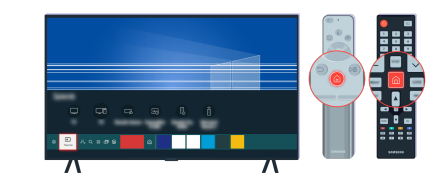
When your TV does not turn on
- The color and design of the TV and its accessories (including the remote control) and the features may differ depending on the model or geographical area.

If your TV does not turn on, check whether the remote control sensor is on.

By holding a reflective object like mirror under the TV, you can easily find the remote control sensor.
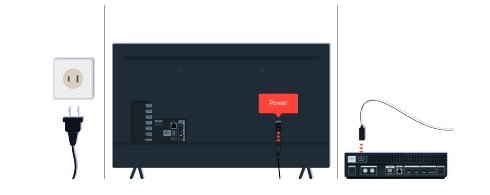
If the remote control sensor is not turned on, unplug the power cable and plug it back in.
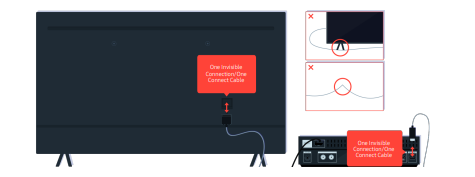
Disconnect and reconnect the One Invisible Connection or One Connect Cable between the TV and the One Connect Box. Make sure that the One Invisible Connection or One Connect Cable is not pinched or bent sharply.
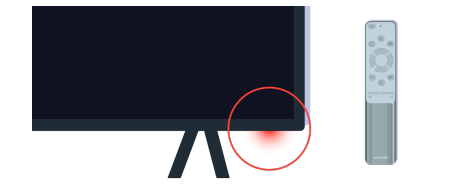
Check the remote control sensor again. If the LED is turned on, press the power button on your remote control to turn on your TV.

If the remote control sensor turns off when you press the power button, your TV is correctly connected to the power supply.
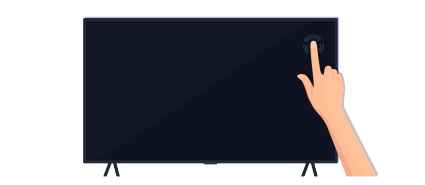
If the TV screen is still blank, softly tap it with your finger. If the part of the screen you tapped on blinks, your TV is correctly connected to the power supply
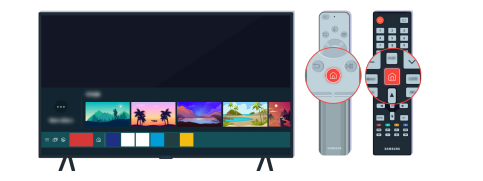
On the remote control, press the button. When the Home Screen appears, the TV is turned on but the connected external device does not work or is not connected correctly.
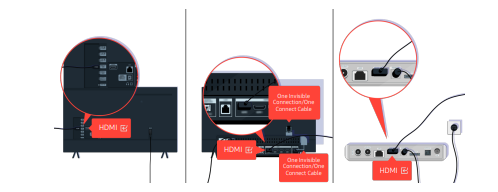
Check the connection of the HDMI cable to your TV or One Connect Box.

Make sure that the external device is turned on.

Accessibility Guidance
Running the Accessibility Shortcuts menu
You can turn on or turn off the accessibility functions such as Voice Guide, Picture Off, Audio (Video) Description, Caption, High Contrast, Enlarge, Grayscale, Color Inversion, Learn TV Remote, Learn Menu Screen, Multi-output Audio, Sign Language Zoom, Slow Button Repeat, Accessibility Settings, and you can move to the Learn TV Remote and Learn Menu Screen pages.
- Samsung Smart Remote / Remote Control On the Samsung Smart Remote or Remote Control, there are 2 thin horizontal rocker buttons next to each other located slightly below the middle of the remote. The one on the left is the volume button. Press and hold the volume button to open the Accessibility Shortcuts menu. Even if the Voice Guide is set to Off or muted, when you press and hold the volume button, the voice guide for Accessibility Shortcuts is enabled.
Running the Accessibility menu functions using the General menu
You can also go to the Accessibility menu from the TV settings menu. This provides more options, for example, to change the speed of Voice Guide. The TV will not verbalize this menu unless Voice Guide is already turned on.
- Press the button.
- Press the left directional button until you reach Settings.
- Press the Select button to open the TV's Settings menu.
- Press the down directional button to reach General, and then press the Select button to open this menu.
- Use the directional buttons to go to the Accessibility menu, and then press the Select button to open this menu.
- The menu will appear with Voice Guide Settings as the fiθϑϩ selection. Highlight Voice Guide Settings, and then press the Select button.
- A menu appears with the options to change Voice Guide, Volume, Speed, Pitch, and TV Background Volume.
- Select the menu using the directional buttons, and then press the Select button.
Using program information
- When watching TV, press the Select button to view program information which then appears at the top of the screen. Voice Guide will say program subtitles or audio descriptions if they are available. To view more detailed program information, press and hold the Select button. Voice Guide will say more details such as a synopsis of the program. Press the left or right directional button to see what you can watch next on the same channel.
- Press the up or down directional button to move to other channels and see which programs are currently being broadcast on them.
Using the guide
If you need to set the clock again, follow the steps below.
- Press the button to open Smart Hub.
- Press the left directional button to move to Settings.
- Press the Select button to open the TV's Settings menu
- Use the up and down directional buttons to move to the General menu, and then press the Select button.
- Use the up and down directional buttons to move to the System Manager menu, and then press the Select button.
- Select the Time menu, and then press the Select button.
- Select the Clock menu, and then press the Select button.
- Select the Clock Mode menu, press the Select button, and then select Auto or Manual.
Using the Channel List
- Using Channel List, you can change the channel or check programs on other digital channels while watching TV.
- Press the button. The Smart Hub home screen appears. Use the left or right directional buttons to move to Live TV, press the up directional button to move to the top row, press the directional button to move to Channel List, and then press the Select button. This shows a list of the channels and the program currently on. The focus will be on the channel you are currently watching, showing channel name, channel number, and program title.
- Use the up and down directional buttons to move within the channel list (or use the (Channel) button to go up and down a page at a time). You can also use the or button to enter a channel number and go to that channel directly.
- Press the left directional button in the Channel List to move to the Category List. Use the up and down directional buttons to move within this list. Press the Select button to choose a category you want from the Category List. The Category List contains All Channels, Favorites, Samsung TV Plus, and Air or Cable. Use the up and down directional buttons to move to a channel you want to view, and then press the Select button.
Using the instant and schedule recording options from the guide screen:
- To record a program that is on now, open the program guide, move to the program, and then press and hold the Select button. You will get a pop-up menu. Use the up and down directional buttons to move to Record. Press the Select button to record the program. You will be returned to the program guide. Recording automatically ends at the time when the program ends.
- To stop recording, press the down directional button while the program being recorded is displayed. The control bar appears. Move the focus to Stop Recording, and then press the Select button. When a pop-up window appears, select Stop.
- To record a program that is on later, move to the program in the Guide, and then press and hold the Select button. You will get a pop-up menu. Use the up and down directional button to move within this menu. Move to the Schedule Recording, and then press and hold the Select button. You will hear a message saying the program has been set to record and then you will be returned to the program guide.
- The icon is placed visually next to the program title to show it is set to record. To fi͝ʒ out if a program is set to record or to cancel a scheduled recording, press the Select button on the program. If it is already set to record, then the option on the menu will be Cancel Scheduled Recording. You can press the Select button to cancel the scheduled recording or just press the button to go back to the program guide without cancelling the recording.
Scheduling recording from the program info window
- Press the Select button while viewing a program to display the program info window. In the program info window, use the left and right directional buttons to select a broadcast scheduled program, and then press the Select button. To schedule a recording for the program, select Schedule Recording.
Changing the recording time
- When recording a live program you can specify how long you want to record for.
- Press the down directional button to display the control bar at the bottom. Press the left or right directional buttons to move to Edit Recording Time, and then press the Select button. A slider scale appears and you will hear the recording time currently set. Use the left and right directional buttons to change the time, and then press the Select button. You will hear a menu that gives information about the recording time. To return to the program you are watching, press the button on the remote.
Deleting a recorded program
You can delete any recorded program.
- Go to the list of Recordings to delete a recorded program.
- Use the up and down directional buttons to move to the recording you want to delete.
- Press the right directional button to move to a list of 3 options.
- Press the down directional button to move to the Delete option, and then press the Select button.
- Press the left directional button to move to the Delete button, and then press the Select button to delete the program title.
See other models: QN85Q80AAFXZA QN75Q80AAFXZA SM-N960UZPAUSC SM-N960UZKAATT SM-N960UZPAVZW
